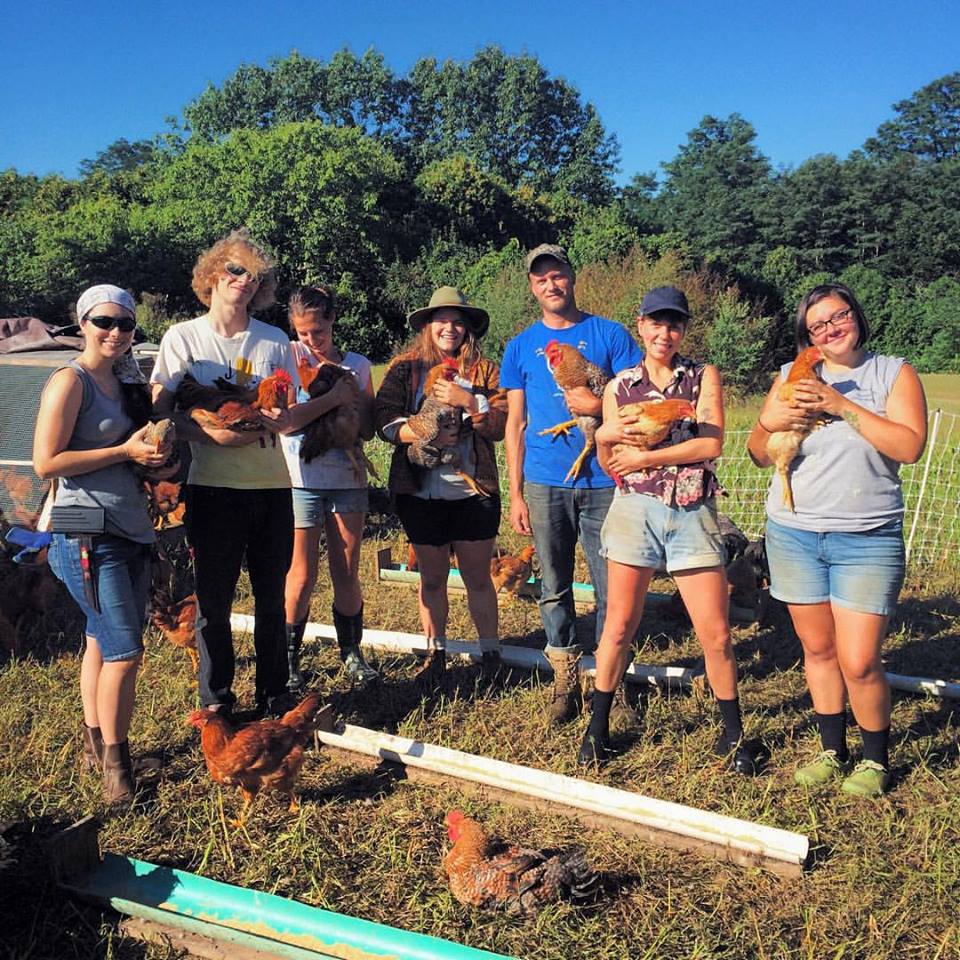For its first four years, The University of Vermont Farmer Training Program (FTP) focused on teaching students how to grow organic fruits and vegetables. This season, the program became even more dynamic with the introduction of a pasture-based chicken operation, where students learned how to raise 200 broiler chickens from day-old chicks to full-grown meat birds.
Andrew Bahrenburg, farm assistant and 2013 FTP alumnus, initiated and managed the chicken component of the farm, earned himself the nickname “Chicken President” among the students. Bahrenburg said he wanted to incorporate chickens on the Catamount Farm for a number of reasons.
“We try to teach students how to run a farm that’s sustainable ecologically and also viable as a small-business model,” Bahrenburg said. “You see more and more farmers adding pastured poultry to the mix because it addresses both concerns. These birds help us with soil fertility, weed management, and pest suppression. But they also add to our product diversity and serve a growing consumer demand for chickens that get to, you know, actually live like chickens.”
With Bahrenburg’s guidance, students helped build and run all facets of the operation, from beginning to end. Joe Farrell, a student who worked on constructing the chicken houses, said, “It felt nice to provide a safe house for the animals.” Coleman Wadsworth, a student who helped build feeders, expressed his eagerness to create a positive environment for the chicks. “It was really exciting to have the chicks come,” he said. “It made me want to build the feeders.”
The chicks, which were shipped from a hatchery in Pennsylvania, arrived at the Catamount Farm in early July. Christa Hunter, part of the first group of students responsible for caring for the birds, described her reaction to their arrival as emotional. “They stole my heart. I’ve seen baby chicks before, but not in this capacity.”
Hunter also demonstrated some of the knowledge she gained by noting the requirements for such a critical period in their young lives. “Temperature needs, water, their inside brooder environment all have to be very specifically maintained,” she said. “Otherwise, they’re going to die.” Hunter spent many hours with the chicks. She brought CDs for them to listen and fall asleep to. “I got to play ‘Mommy’ for a bit,” she said.
Daily “chicken chores” were divided into morning and evening shifts. Once the chickens were moved from brooder to pasture, morning chores included letting the chickens out of their houses and into the fenced-in area, and filling food and water containers. In the evening, the chickens were corralled back to their houses for the night and given a second feeding.
Other chores included moving the chicken houses and fencing. As student Patrick Campbell explained, “Every three days, we would move the chicken tractors [houses]. About once a week, we moved the electric fence.” Moving the chickens’ habitat allowed them to dig and aerate the soil while foraging for insects and vegetation. At the same time, their droppings added nitrogen to the soil, which helps with fertility. Throughout their lives, chickens on the Catamount Farm helped improve and prepare the soil in a field that next year’s FTP students will put into production.
Although Bahrenburg wanted to feed the chickens organic grain, the operation wouldn’t have been financially possible that way in the first year, since organic grain costs nearly twice as much as conventional. To help keep the amount and costs of grain feed down, aside from foraging, the chickens were given vegetable scraps from the farm.
One setback to the operation was unexpected processing fees. Originally, Bahrenburg planned for the birds to be harvested by the students on the farm, but liability constraints forced them to be processed at a state-inspected facility. The chickens were collected from the Catamount Farm and processed at Maple Wind Farm in mid-September.
Overall, however, Bahrenburg was pleased with the success of the operation in its first year. “Our students raised these birds with the same passion and curiosity as they tackle every other project on this farm. And many of them are now considering meat birds for their future farm businesses. But I also judge the project by its final product, and our chickens are delicious. You can definitely taste the difference,” he said.
Students had a variety of reactions to raising the chickens. Some saw the operation as a way to foster a connection with the animals that eventually became food. Wadsworth said, “I felt more responsible for what I was eating.” Some, like Campbell, were happy to see and be a part of how the birds were raised: “We raised the birds in a much more humane way than most people raise chickens.” Others, like Taylor Gallagher, felt good about raising the chickens from quality of life and environmental standpoints: “I used to think all meat was bad because all meat involves killing animals. But sustainable meat-raising really puts an emphasis on life quality. I’ve never had that experience before…just being truly respectful to the land and the animals.”
If you’d like to savor chicken raised by FTP students on the Catamount Farm, it’s not too late. Contact Catamount Farm at catfarm@uvm.edu. The chickens are sold whole for $6 per pound.











